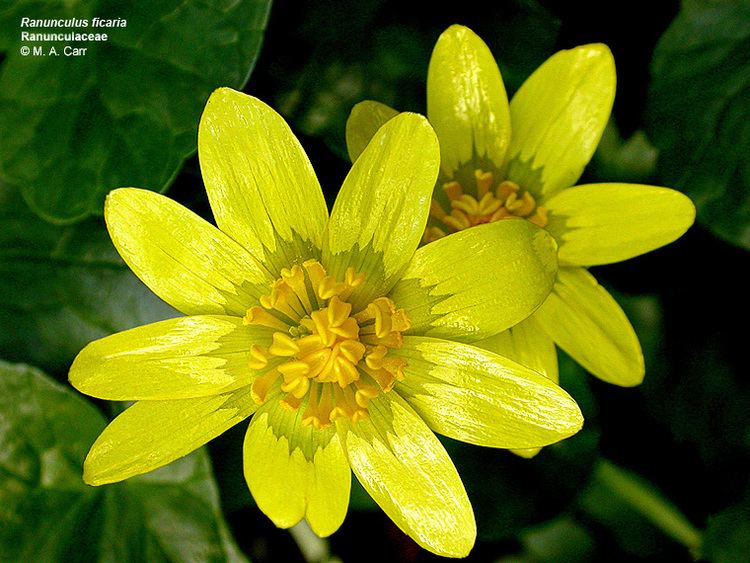Scientific name Ranunculaceae | ||
 | ||
Lower classifications | ||
Taxonomy and diversity of ranunculaceae
Ranunculaceae (buttercup or crowfoot family; Latin rānunculus "little frog", from rāna "frog") is a family of over 2,000 known species of flowering plants in 43 genera, distributed worldwide.
Contents
- Taxonomy and diversity of ranunculaceae
- Description
- Taxonomy
- Subdivision
- Molecular phylogenetics
- Genera
- Fossil record
- Uses
- References

The largest genera are Ranunculus (600 species), Delphinium (365), Thalictrum (330), Clematis (325), and Aconitum (300).
Taxonomy and diversity of ranunculaceae
Description
Ranunculaceae are mostly herbaceous annuals or perennials, but some woody climbers (such as Clematis) or shrubs (e.g. Xanthorhiza).

Most members of the family have bisexual flowers which can be showy or inconspicuous, and can be radially or bilaterally symmetrical. The sepals and petals are generally free (unfused) and typically number four or five. In many species, the sepals are colorful and appear petal-like. In these species, the petals can be inconspicuous or absent. The stems are unarmed. The leaves are variable. Most species have both basal and cauline (stem) leaves, which are usually compound or lobed but can be simple. They are typically alternate, or occasionally opposite or even whorled. Many species, especially the perennials form rhizomes that develop new roots each year.
Flowers may be solitary, but are frequently found aggregated in cymes, panicles, or spikes.
The fruit is most commonly an Achene (e.g. Ranunculus, Clematis) or a follicle (e.g. Helleborus, Nigella).

Ranunculaceae contain protoanemonin, which is toxic to humans and animals. Other poisonous or toxic compounds, alkaloids and glycosides, are also common.
Taxonomy

Takhtajan (1997) included the Ranunculaceae as the only family in the Ranunculales which he placed in a subclass, the Ranunculidae, instead of a superorder. Previously, Thorn (1992) placed the Ranunculaceae in the Berberidales, an order within the Superorder Magnolianae. Earlier Cronquist in 1981 included the Ranunculaceae along with seven other families in the Rancunculales which was included in the Magnoliidae, which he regarded as a subclass. David, (2010) placed the Ranuculaceae, together with the Eupteleaceae, Lardizabalaceae, Menispermaceae, Berberidaceae, and Papaveraceae in the Ranunculales, the only order in the superorder Ranunculanae. This follows the work of the Angiosperm Phylogeny Group.

The family Ranunculaceae sensu stricto (APG) is one of seven families included in the order Ranunculales within the eudicots according to the Angiosperm Phylogeny Group classification. The family is monophyletic with Glaucidium as sister to the remaining genera. This phylogeny is illustrated in the APG Poster.
Subdivision
Early subdivisions of the family, such as Adanson (1763), simply divided it based on one-seeded or many-seeded fruit. Prantl (1887) envisaged three tribes, Paeonieae, Hellebroreae and Anemoneae with Paeonia, Glaucidium and Hydrastis forming Paeoniaae. By the twentieth century Langlet (1932) used chromosome types to create two subfamilies, Ranunculoideae and Thalictroideae. In 1966 Tamura further developed Langlet's system by adding floral characteristics with six subfamilies;
but by 1988 he had reduced Coptidoideae to a tribe within Isopyroideae, leaving five subfamilies, an arrangement he continued in his 1993 monograph, dividing the larger subfamilies into tribes, though by then Paeonia and Glaucidium were no longer considered to belong to Ranunculaceae. Paeonia was separated from Ranuculaceae and placed in its own family of Paeoniaceae (order Saxifragales). other genera originally included in Ranunculaceae include Circaeaster which was placed in its own family Circaeasteraceae.
Tamura's complete system was structured as follows;
The genus Glaucidium, having been moved to its own family (Glaucidiaceae), has since been restored to Ranuculaceae.
Molecular phylogenetics
When subjected to molecular phylogenetic analysis only Thalictroideae is monophyletic. The position of Glaucidium and some of its unique morphological characteristics prompted Stevens to suggest that it be given subfamilial rank as the monotypic Glaucidioideae. Similarly Hydrastis has been assigned to subfamily Hydrastidoideae. Both genera are represented by a single species, Glaucidium palmatum and Hydrastis canadense respectively.
The relationships between the genera suggest the existence of three major clades corresponding to Coptidoideae, Thalictroideae (clade A) and Ranunculoideae (clade F). The latter is the largest with four subclades (B–E). Of these C corresponds to Delphineae, D to Cimicifugae and E to Ranunculoideae. Consequently, Wang and colleagues (2009) proposed a new classification with five subfamilies, and further subdividing Ranunculoideae into ten tribes. The relationship between the subfamilies is shown in the cladogram;
In addition to the two monotypic subgenera, Coptoideae has 17 species and Thalictroideae has 450, including Thalictrum and Aquilegia. The other genera (2025 species, 81% of the family) belong to Ranunculoideae. Kingdonia had been included by Tamura in Anemoneae, but is now added to Circaeasteraceae.
Genera
Ranunculaceae contains approximately 43 genera.
Previous genera
Fossil record
Fossils of fruits, pollen, seeds, and leaves are known from several dozen locations. The fossil record begins in the early Cretaceous and continues throughout the Tertiary. In most cases, the fossils are assigned to extant genera, or show a close relationship to a particular extant genus.
Uses
Some Ranunculaceae are used as herbal medicines because of their alkaloids and glycosides, such as Hydrastis canadensis (goldenseal), whose root is used as a tonic. More than 30 species are used in homeopathy, including Aconitum napellus, Cimicifuga racemosa, Clematis recta, Clematis virginiana, Hydrastis canadensis, Ranunculus bulbosus, Helleborus niger, Delphinium staphisagria, Pulsatilla nigricans. Many genera are well known as cultivated flowers, such as Aconitum (monkshood), Clematis, Consolida (larkspur), Delphinium, Helleborus (Christmas rose), Trollius (globeflower). The seeds of Nigella sativa are used as a spice in Indian and Middle Eastern cuisine.
